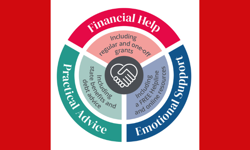But is it a signal that as publishers we are capable of organising ourselves in order to take on the enormous challenges that are ahead. Well not so far.
It is not enough to say that newspapers are simply being engulfed by new digital entrants. They are also engulfed by unfair regulatory control, which in most markets in the world inhibits them from competing fairly.
Why is it for example that Microsoft is allowed to control 90% of the world’s computers, perhaps in ways that none of us understand. Yet Trinity Mirror – which takes 3% of the UK communications industry, and Gannett, which is less than 1% of the US equivalent - aren’t allowed to sneeze without a government enquiry. Everywhere you look – whether the society is free, or controlled – the answer is the same: paranoia.
To reflect on that great anonymous quotation: “Just because you're not paranoid, does not mean to say they are not out to get you”, this does not mean to say that newspapers should not be a lot better at collectively dealing with their market situation and emerging competition.
The first question relates to competition. There are few markets in the world, where newspapers are truly competitive. The UK, Japan, Austria, all feature a range of strong national competitors, but in most countries, particularly the USA and Germany, the industry is dominated by local players, who compete more with other media and forms of communication than with other newspapers. Indeed in the UK two-thirds of the industry is locally based. Here in France around three quarters is local.
This issue of competition relates more to how our industry responds to the ever-widening range of media alternatives - new entrants and substitutes - than themselves.
In Japan, newspapers are working hard to control their audiences, by blocking links, and forcing consumers to go directly to their sites. However, while in the short-term it appears to be protecting their print circulations, it is not and will not attract the next generation of media consumers, who are seeking a more open range of media sources.
When it comes to competing in tomorrow’s world, newspapers have far more to gain by working together whether with or against the new generation of digital media. Obvious industry strategies should be:
• A collective, single vertical solution for each category of classified.
• A shared industry search solution that covers all news sources, in a single experience. I’ve long been of the view that it is better to work with Google, than not, but in reality the quality of the Google search can still be greatly improved upon, in terms of clarity and granularity. How much better to have an authoritative single source, that includes all the key media players, as well as granulated access to citizen and organisational opinion?
• A joint public service aggregator, comprising all important public sector information, again with credibility and granularity.
These are issues of competitive product advantage, but there are also issues of industrial operational advantage. If one examines the value chain process of media - put loosely: Gather. Package. Distribute. Market – two issues come to mind.
The first is that the value chain process is increasingly consumer driven. Digital media enable consumers to edit and repackage, from a wider range of sources. True the tools don’t, yet, allow the level of focus that one would want - hence my comments above. But the general trend of consumers taking control can only accelerate.
The second is where the value lies in the value chain. The answer here is it lies at the extremes. At the start of the chain, it is in terms of content creation and interpretation. This largely sets the product values of the service, and therefore the brand credentials.
At the other extreme, lies customer knowledge and control. Today, business control lies around who owns and understands customers. What they need. What they are interested in. What will motivate them to pay, both for content, and for advertisers’ products and services. Customer control is as important as creative control.
In the middle of the chain, there is little competitive advantage to be gained. Printed newspapers have long understood that they are better off sharing distribution (unless paranoid government puts a stop to it), and more recently printing. Imagine if we all decided to have our own digital network! But publishers need to learn to work closer together in the digital distribution part of the value chain, because this is where they can gain competitive advantage against the real enemy, and maximise revenue opportunities.
Google and Yahoo are masters at the latter end of the value chain. But they don’t, to-date, actively operate at the front end. We newspaper people must simply get better at understanding where the competitive advantage and value lies, and get better at working together to realise them both.
Imagine if every time you searched for news you were taken to single news marketplace? Now that just might make the enemies paranoid.










